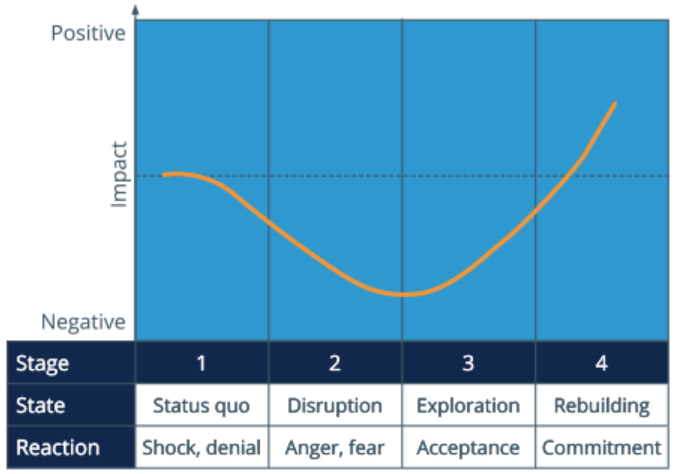Change is an inevitable part of running a business and can be disruptive if not properly managed.
Managers play a big role in supporting workforces through periods of change and understanding your role at each stage in the process is vital.
We walk you through the issue.

Types of change
Change in a workplace takes many forms, including:
- Change related to people, systems or the organisation as a whole;
- Radical or minor;
- Proactive or reactive; and
- Evolutionary or revolutionary.
While there are several change management models to help guide you, there is no single best practice model.
CCIWA Senior Human Resources Consultant Marcia Lawrence says an employee’s capacity to change is influenced by how that change is communicated.
“Therefore, how you manage and lead the workplace change will have a direct impact on whether you achieve the desired outcomes,” she says. “A change management plan is key, underpinned by visible support and commitment of organisational leaders.”
Lawrence says employers should also be aware that they have obligations under modern awards and enterprise agreements to consult with employees on a major workplace change or roster changes.
“In addition, the Fair Work Act 2009 requires employers to consult with employees in certain situations, whether or not a modern award or enterprise agreement applies,” she says.
“Employers may also choose to consult with employees and their representatives as a matter of best practice. Research on resistance to change has shown that it can be mitigated by involving employees in the decision-making process.”
Adapting to change
It is normal for people to undergo a range of emotions when they hear about a change.
Swiss-American psychiatrist Elisabeth Kubler-Ross created a change curve, which represents the reactions people experience when responding to change.

- Shock or denial, which may be experienced when someone first hears about a change being made to the status quo.
- Anger or fear about any potential disruptive impacts of the change.
- Acceptance that the change must happen and exploring ways it impacts them.
- Once people embrace the change and commit themselves to a new way of working, they can make a positive contribution to an organisation’s rebuilding process.
Individuals may enter the curve at any stage and may backslide or get stuck in certain stages.
Your role responding to change
As a manager, you are responsible for helping your team members reach the final stage of the change curve.
To do so, you will need to play roles to ensure the success of the change initiative.
These roles include being a:
a) Liaising with senior management
Where a change is coming from senior management, you will need to understand the change yourself.
This will require you to liaise with senior management to understand the purpose and direction of the change.
This will help you to effectively promote and explain the need for change to your team.
b) Liaising with your team
Where you want to implement a change yourself, you should liaise with your team members about the change you want to introduce.
This will allow team members to make suggestions and provide input on what should be involved in the change.
You can help your team develop a sense of ownership and become strong advocates of the change process by:
- Involving them in the change; and
- Giving them the opportunity to take responsibility and accountability for certain aspects of the change.
It will also allow you to coach and support your team during the time of change and help them to quickly move towards the final stage of the change curve.
Once the key aspects of the change initiative have been established, you will need to communicate the details of the change to your team.
Whilst communicating with your team, different members of the team may react in different ways, according to the change curve. Therefore, it is important for you to effectively communicate relevant information about the change initiative. This will include explaining:
- What has created the need for the change;
- The benefits of the change;
- What might happen if the change is not made; and
- Where they can go for more information if they need it.
You should also take the time to answer questions that arise.
While some team members will immediately enter the third or fourth stage of the change curve, others will become stuck in the second stage.
For these team members, you will need to find various ways to promote the change.
This can often be accomplished by highlighting the benefits of the change for each employee, for example:
- Career development opportunities;
- More efficient ways of working;
- Increased job security; or
- Financial incentives.
It is important to maintain your honesty while advocating for the change.
If you lie about the benefits, your team is likely to realise this and be more resistant to the change.
This requires you to help develop the change that you have been promoting and communicating into practical skills.
Coaching should begin immediately after the change has been communicated and continue throughout the change process.
Resistance manager
You may find that some team members continue to resist change. In these situations, you may need to implement a range of strategies, including:
- Listening to your team members and then address the concerns they raise;
- Empowering employees to contribute to the change, where appropriate; or
- Encouraging your team to provide feedback and suggestions for improvement.
Identifying resistance to change
The actions of your team members and how they are talking about a change in meetings and corridor conversations may give you some indication as to whether there is resistance to a change.
Signs of resistance may include snide or sarcastic remarks, nit-picking details, verbal criticism of the change, missing meetings or other commitments, or sabotaging your efforts to explain the change.
CCIWA’s new HR Consulting service provides advice to businesses on issues such as these. Get in touch on (08) 9365 7746.
CCIWA’s eLearning Library has a suite of interactive modules on several topics to help run your business, including managing change.
For general advice contact our Employee Relations Advice Centre on (08) 9365 7660 or [email protected].












